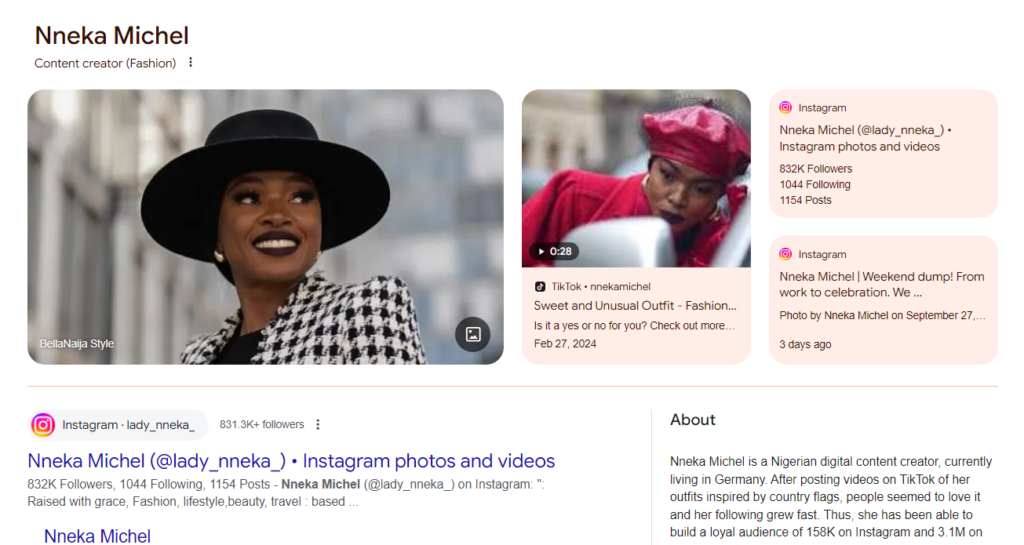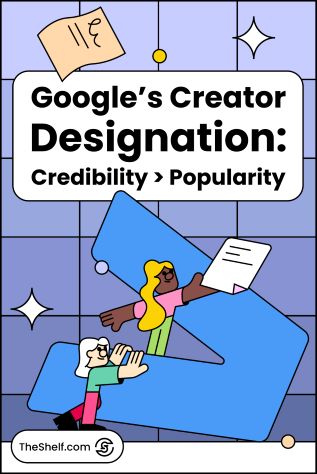The role of influencers is undergoing a significant transformation. As brands increasingly rely on influencer partnerships to connect with their target audiences, it’s important to recognize that credibility is becoming more important than sheer popularity. Enter Google’s Creator Designation (my name, not theirs), a game-changer for both influencers and brands.
Google’s what? I saw a headline from Search Engine Land in my Google News feed that talked about Google recognizing Creators as person entities. And the proverbial light bulb illuminated over my head. This feature isn’t fully rolled out yet. Much like Google’s AI Overview and the Karma chameleon, it comes and goes. Nevertheless, as I am something of an SEO geek (or expert, depending on whom you ask), I’m talking about it RIGHT NOW because I can make a pretty solid estimation on the wonderful implications of the Creator designation. So, in this article, let’s take a 360-degree look at the moving pieces (I’ve identified three) that directly impact this shift.
Search-Engine Famous: Here’s What Google’s “Creator” Designation Means
So, what is the Creator designation? Or, what will it be when Google eventually rolls it out?
In the simplest terms, Google’s Creator Designation is a way for Google to identify a Person Entity who creates content. A whaa? A Person Entity is someone who is uniquely identifiable by search engines. In short, someone who is “Search-Engine Famous”. In the case of a Creator, it means search engines recognize this person as a content creator who has expertise and/or influence in a specific area or in specific categories (marketing, parenting, tech, medicine, etc.)
The Creator Designation aims to fortify this concept of Person Entities to enhance content credibility. It helps audiences find creators who not only have great content but also deliver it with expertise and trustworthiness. By highlighting creators who meet these criteria, Google is setting the stage for a new era where quality trumps popularity.

The Creator vs. Influencer Dichotomy
When you dive into the world of digital marketing, it’s easy to get a bit tangled in the terms “creator” and “influencer.” They might sound like they play the same role, but in reality, they’re like apples and oranges—each has its unique flavor and purpose.
Let’s start with creators. Think of them as the artists of the digital landscape. They’ve mastered the art of making content that not only grabs attention but also gets shared across platforms. TikTok is a perfect example here; the platform thrives on its interest graph, where creators shine by producing videos that are not just entertaining but also algorithm-friendly.
These folks are fantastic at generating top-of-funnel buzz, making them ideal for driving awareness for brands. Their content is catchy, memorable, and often just what you need to get people talking. Most of our awareness campaigns now include an in-depth strategy for working with these types of content creators, and we’ve seen remarkable results doing so.
@frankiesfun That did not go as planned 😭 At least I got my Member’s Mark Tuxedo Bar Cake Sundae @Sam’s Club #MembersMark #SamsPartner #SamsClub ♬ original sound – Frankie Lagana
The post above from @frankieisfun is a fantastic example of interest graph content from a phenomenal creator. This video pushed Frankie to the #2 spot on TikTok’s Top Creators chart for four consecutive weeks. It was part of a campaign we ran for a Fortune 500 CPG brand, and it received glowing 🦄 feedback directly from TikTok on its exceptional performance. So much so, that TikTok ended up sending our client an email celebrating the campaign for consistently driving user engagement far beyond industry benchmarks. TikTok recommended the brand continue with the strategy we implemented, citing the unparalleled user engagement and success of our approach. That’s the power of content creators – the potential for unparalleled user engagement.
Now, let’s pivot to influencers. These are the people who have dedicated time and energy to build a community around their niche. They’re not just about the numbers; they’ve invested in developing deeper connections with their followers. This is why they’re super effective for mid-funnel marketing efforts, where trust and relationships matter most. Influencers bring expertise to the table, whether it’s in fashion, fitness, or tech, and their followers are there for their authentic insights and recommendations.
So, it’s not that influencers are just out to chase followers; they serve a distinct purpose in influencer campaigns. They help brands establish credibility and foster meaningful relationships with their audiences.
In a nutshell, creators are your go-to for creating eye-catching content that raises awareness, while influencers are the trusted voices that can turn that interest into engagement and, ultimately, sales.
By recognizing these differences, brands can strategize more effectively and tap into the strengths of both creators and influencers. With Google’s Creator Designation in play, this understanding becomes even more essential, highlighting the value of authenticity and expertise in today’s digital marketing landscape. Now, back to the three moving pieces I mentioned earlier in this post.
Moving Piece #1: E-E-A-T

Alright, let’s unpack the first moving piece, which is the concept of E-E-A-T. E-E-A-T stands for Experience, Expertise, Authoritativeness, and Trustworthiness. You might be wondering why we’re giving a shout-out to a bunch of buzzwords, but trust me, these four components are the building blocks of high-quality content that Google really values.
First off, let’s talk about Experience. This component was added in December 2022 and emphasizes that creators should not only know their stuff but also have real-world experience to back it up. It’s all about demonstrating a connection to the content they produce. Think of it this way: if you’re writing about the best hiking trails, wouldn’t you want to hear from someone who’s actually hiked those trails rather than just Googled them? This addition shifts the focus from mere academic knowledge to practical insights, making content more relatable and authentic.
Next, we have Expertise. This isn’t just about knowing facts; it’s about showcasing a deep understanding of a subject. For example, a nutritionist writing about healthy eating should ideally have formal training in that area. This level of knowledge adds credibility and ensures that readers receive accurate and valuable information.
Remember when No7 Beauty Company launched the Creator Collective to provide skincare education to its influencers? The whole goal of that program was to equip influencers with reliable, factually correct information about skincare, helping them create trustworthy content for their audiences. That’s what we’re talking about when we say expertise. No7’s goal was to upskill its influencers and make them trustworthy experts rather than simply giving them the talking points to include about its products in the creator’s pics and videos.
Authoritativeness is the next signal we want to talk about. This one’s about your reputation in your niche. Are you known as the go-to person in your field? This doesn’t happen overnight, but through consistently providing high-quality content, engaging with your audience, and building relationships within your industry, you can establish yourself as an authority.
Finally, we can’t forget Trustworthiness. In an era where misinformation can spread like wildfire, it’s essential for creators to build trust with their audience. This means being transparent about sources, avoiding sensationalism, and maintaining a consistent voice that resonates with followers. Trust is the cornerstone of any successful relationship, and it’s no different in the digital world.
For both creators and brands, understanding and applying E-E-A-T standards is crucial. These principles not only enhance content credibility but also align with Google’s mission to promote authentic content. In a marketplace where consumers crave reliable information, leveraging E-E-A-T can significantly improve your content strategy and audience engagement.
Moving Piece #2: The Trend Toward Crowd-sourced Intelligence
Today’s consumers are all about authenticity and trust when it comes to their purchasing decisions, and influencers are key players in shaping those perceptions. But in recent years, there’s been a measurable change in how people source information, and increasingly, younger consumers are turning to social media and peer-driven insights in lieu of Google-curated search results.
TikTok
Ah, TikTok—the platform that has turned the digital world on its head, and not just with catchy dance trends! As it continues to shape cultural conversations, TikTok is also becoming a major player in the shift for how consumers search for information.
According to Adobe, 40 percent of Americans now use TikTok as a search engine. Not to be confused with the misquoted stat that surfaced a few years ago that said 40 percent of Gen Z prefer TikTok over Google (in reality, that stat was meant to communicate that 40ish percent of Gen Z were using TikTok over Google Maps to search for new places to eat).
That’s not insignificant – 40 percent of Americans using a social media channel instead of a search engine. This trend challenges traditional influencer marketing models and raises questions about how brands can effectively reach potential customers in this new landscape.
Reddit is no longer just a place for niche interests and meme debates—it’s evolving into a major search engine. With two-thirds of Americans using it to find information at least once a week, Reddit has gained a reputation for offering trustworthy, community-driven answers that go beyond the surface level.
Users are seeking everything from product reviews to life hacks on social media channels. This shift represents a broader evolution in the way we consume content and engage with brands.
Moving Piece #3: FTC Ban on Buying Followers and Engagement
So, one of the most significant shifts comes courtesy of the Federal Trade Commission (FTC), which officially banned the buying of followers and engagement in August of this year. With the FTC’s recent crackdown, anyone caught purchasing followers or engagement could face hefty fines. This regulation is designed to encourage genuine interactions between influencers and their audiences, ultimately promoting a culture of authenticity in a space that historically has been guilty of prioritizing numbers over meaningful connections. The FTC’s actions will no doubt encourage both creators and brands to cultivate their communities organically, relying on true engagement rather than inflated metrics.
Building Trust Through Transparency
This regulation aligns closely with the concept of a specific (and public-facing) Creator category for Person Entities. Plus, it ties directly into the guidelines Google’s already established with the E-E-A-T framework. Like I said, Google’s initiative emphasizes the importance of credibility in content creation. By removing the option to buy followers (or at least making the penalties for doing so substantial enough for potential violators to rethink that strategy), both the FTC and Google are reinforcing the idea that authentic engagement leads to more trustworthy content.
In a time when consumers are increasingly discerning about who they trust online (seriously, Gen Z has a BS filter that has ne’er been seen in the history of mankind), these standards help pave the way for more transparent relationships between brands and their audiences.
This evolution in the digital ecosystem is crucial for fostering real relationships where genuine connections take precedence over superficial popularity. This ensures that both consumers and brands benefit from more honest interactions in the marketplace.
The Need for Critical Evaluation
Like Aunt May told Peter Parker, with great power comes great responsibility—or, in this case, a critical need for discernment. As content becomes increasingly decentralized, users must sift through a vast sea of information to determine what is credible. With TikTok videos often going viral for their entertainment value rather than their accuracy, brands must tread carefully. The connection to Google’s Creator Designation and the E-E-A-T framework is clear here: as social platforms continue to influence consumer behavior, creators need to prioritize authenticity and expertise in their content to maintain trust.
And as brands adapt to this evolving landscape, influencer selection is likely to change. Eventually, companies may lean more towards collaborating with creators who have that Creator Designation from Google, valuing authenticity over mere follower counts.
In essence, social media is not just reshaping how we discover and interact with brands; it’s encouraging a more thoughtful and authentic approach to content creation. As we move forward, the most successful brands will be those that focus on genuine connections and credible storytelling—an approach that aligns perfectly with the ethos of Google’s Creator Designation and E-E-A-T standards.



